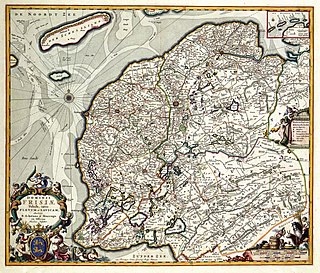Related Research Articles
Henry the Proud, a member of the House of Welf, was Duke of Bavaria from 1126 to 1138 and Duke of Saxony as well as Margrave of Tuscany and Duke of Spoleto from 1137 until his death. In 1138 he was a candidate for the election as King of the Romans but was defeated by Conrad of Hohenstaufen.

The Duchy of Saxony was originally the area settled by the Saxons in the late Early Middle Ages, when they were subdued by Charlemagne during the Saxon Wars from 772 AD and incorporated into the Carolingian Empire (Francia) by 804. Upon the 843 Treaty of Verdun, Saxony was one of the five German stem duchies of East Francia; Duke Henry the Fowler was elected German king in 919.

The House of Welf is a European dynasty that has included many German and British monarchs from the 11th to 20th century and Emperor Ivan VI of Russia in the 18th century. The originally Franconian family from the Meuse-Moselle area was closely related to the imperial family of the Carolingians.
Otto of Nordheim was Duke of Bavaria from 1061 until 1070. He was one of the leaders of the Saxon revolt of 1073–1075 and the Saxon revolt of 1077–1088 against King Henry IV of Germany.

Bruno, also called Brun or Braun, a member of the Ottonian dynasty, was Duke of Saxony from 866 until his death in 880. He is rated as an ancestor of the Brunonids, a cadet branch of the Ottonians, though an affiliation is uncertain. Bruno was killed fighting against Norse warriors in the Battle of Lüneburg Heath and is venerated as one of the Ebsdorf Martyrs.

Hermann Billung was the margrave of the Billung March from 936 until his death. The first of the Saxon House of Billung, Hermann was a trusted lieutenant of Emperor Otto I.
Gertrud of Brunswick was Countess of Katlenburg by marriage to Dietrich II, Count of Katlenburg, Margravine of Frisia by marriage to Henry, Margrave of Frisia, and Margravine of Meissen by marriage to margrave Henry I.

Richenza of Northeim was Duchess of Saxony from 1106, Queen of Germany from 1125 and Holy Roman Empress from 1133 as the wife of Lothair of Supplinburg.

Gertrude of Süpplingenburg was Duchess of Bavaria, Margravine of Tuscany, and Duchess of Saxony by marriage to Henry X, Duke of Bavaria, and Margravine of Austria and Duchess of Bavaria by marriage to Henry II, Duke of Austria. She was regent of Saxony during the minority of her son Henry the Lion in 1139–1142.
Egbert II was Count of Brunswick and Margrave of Meissen. He was the eldest son of the Margrave Egbert I of the Brunonen family.

Henry I (1070–1103), nicknamed the Old, a member of the House of Wettin, was Count of Eilenburg as well as Margrave of the Saxon Eastern March from 1081 and Margrave of Meissen from 1089 until his death.
Egbert I was the Margrave of Meissen from 1067 until his early death the next year. Egbert was the Count of Brunswick from about 1038, when his father, Liudolf, Margrave of Frisia, died. His mother was Gertrude, the sister of Pope Leo IX.

Liudolf of Brunswick was Margrave of Frisia, Count of Brunswick, Count in the Derlingau and the Gudingau.

The Derlingau was an early medieval county (Gau) of the Duchy of Saxony.
Henry the Fat, also known as Henry of Nordheim or Northeim, was Count in Rittigau and Eichsfeld from 1083 onwards, and was the Margrave of Frisia from 14 April 1099 until he was murdered in 1101. He was the father of Empress Richenza.
The County of Brunswick was a county in the medieval Duchy of Saxony. It existed from about the 9th century until 1235, when it was raised to a duchy, the Duchy of Brunswick-Lüneburg.

The Lordship of Frisia or Lordship of Friesland was a feudal dominion in the Netherlands. It was formed in 1498 by King Maximilian I and reformed in 1524 when Emperor Charles V conquered Frisia.
Richenza was a German noblewoman. By her first marriage, she was Countess of Werl. By her second marriage, she was Countess of Northeim, and from 1061 to 1070, Duchess of Bavaria.
A royal election was held in the Kingdom of Germany after the death of childless Emperor Otto III. It was won by Duke Henry IV of Bavaria among accusations of uncustomary practices.
Gertrude the Elder of Brunswick, also known as Gertrude of Egisheim, donated together with her husband Liudolf of Brunswick the collegiate church of St. Blasius in Braunschweig and founded the later so-called Welfenschatz.
References
- Freytag, Hans-Joachim (1955), "Brunonen", Neue Deutsche Biographie (in German), vol. 2, Berlin: Duncker & Humblot, pp. 684–685
- Brüsch, Tania (2000). Die Brunonen, ihre Grafschaften und die sächsische Geschichte: Herrschaftsbildung und Adelsbewußtsein im 11. Jahrhundert [The Brunonids, their Counties and the History of Saxony: Development of Power and the Consciousness of Nobility during the 11th Century] (in German). Husum: Matthiesen. ISBN 3-7868-1459-7.